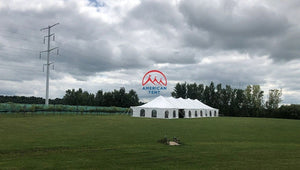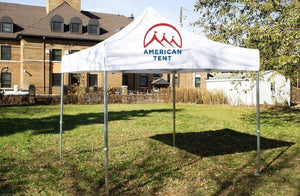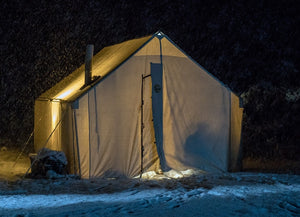For larger tent setups, it’s especially important to follow the manufacturer’s guidelines on how much weight is needed and where it should be placed. Incorrect or uneven ballasting can lead to instability, tent collapse, or serious injury. Always check your tent specs and use the right anchoring method for the setup.
Properly securing your canopy with weights is an essential step in the set-up process if you want to ensure your event tent doesn’t accidentally fly away in inclement weather. Yes, even a sturdy frame tent can be surprisingly prone to get ripped from the ground in high winds and rain if there aren’t enough tent weights securing every corner. Luckily, figuring out how much weight is needed to hold down a tent for your event is relatively easy, and there are quite a few options out there to make sure your event tent stays in place. Keep reading for our expert advice on the types of securing methods you can use, how much weight canopy tents you’ll need, making your own tent weights, canopy sand bags, and more!
Tent Anchors vs. Tent Weights

There are two basic options when it comes to securing your canopy legs; anchors or awning weights. Anchors attach to the tent’s canopy and get staked into the ground, whereas weights simply hold down and secure the canopy with their weight alone and do not have to be staked into the ground.
The main difference between tent anchors and pop-up tent weights to hold down the canopy is versatility. Tent anchors, or stakes, must be driven into the ground, making them impossible to use if you are setting up your canopy tent at an outdoor venue with concrete, or a venue that does not allow staking into the ground. It is essential to contact your venue ahead of time, be it for a festival, outdoor market, or vendor fair, and ask about the area your tent will be set up in and the requirements for tarp weights.
Weights for pop-up canopy or other tent models, on the other hand, are a versatile option that can work anywhere and on any budget. Not only can you purchase convenient, size-effective commercial tent weights, but you can also create your own for a minimal cost. The main downside of tent weights is, well, the weight. With recommendations of providing at least one 40-pound weight at every tent leg to secure a small, 10x10 tent, you will have to put in extra labor and planning to transport and set up tent weights compared to tent anchors.
So, what’s the best way to secure your canopy tent: anchored or tent weights? If you are going to a venue where you can’t stake into the ground, you’re going to need tent weights, no question. They are also a cost-effective, simple option that will work in high winds and rain. We recommend choosing tent stakes if you want an easier set up and transportation of your pop-up tent awning that doesn't require packing and lugging around multiple heavy tent weights.
Types of Tent Weights

Concrete Blocks
Concrete weights are a low-cost option that can be used to secure your tent and are generally fairly easy to transport and set up. They don’t look the best, but for a trade show venue event where people will be looking at the inside of your tent as opposed to the outside, canopy cement blocks work perfectly to secure your tent.
It’s worth noting that while concrete blocks are cost-effective, they’re also heavy and bulky. This can increase transportation costs and put added strain on your crew during setup and teardown. If you choose to secure your tent with concrete weights, be sure you have the right equipment, like dollies or forklifts, to move them safely. You’ll also need adequate storage space, as these blocks take up quite a bit of room when not in use.
Sandbags
Sandbags are a common tent weight solution in disaster relief and emergency situations, valued for their speed and simplicity. They’ve been used for decades to quickly secure temporary shelters, especially pop-up canopies. While they can be effective and affordable, standard sandbags aren’t ideal for repeated use—especially in wet conditions. If you plan to use them more than once or in bad weather.
While sandbags are often used with pop-up tents or in emergency situations, they aren’t recommended for long-term or professional use. Tent safety should always be a top priority, and sandbags are not an approved or reliable method for securing commercial tents. If you need a more secure and code-compliant solution, consider using ballasting systems or concrete weights designed specifically for tents.
Important: This method should never be used for large or professional tent setups, where proper ballasting and anchoring systems are required for safety and compliance.
Water Weights

Water weights, such as Giffy Ballasts from American Tent, can be purchased online and might answer the problem of transportation that some tent weights cause. They stack well and are easy to transport, weighing only 30lbs when empty. This means if you have access to water at your venue, you’ll be able to bring in virtually-weightless plastic cases that become weights when filled with water.
What sets the Giffy Tent Ballasting System apart from other water weight options is that it’s specifically engineered to safely anchor tents. Unlike traditional water barrels—like 55-gallon drums—Giffy Ballasts are designed with safety and stability in mind. Standard barrels often don’t hold enough weight, lack a plate connection system (which can lead to tipping or sliding), and can’t stack into each other for efficient storage. Giffy Ballasts solve all of those issues with a compact, reliable, and purpose-built design.
Weight Plates
Weight plates are similar to water weights and may come pre-filled with sand or another weighted material, or arrive empty so you can fill the weights at your venue or with your own weight material. They can attach to your tent frame and blend well into the overall look of the tent.
Dumbbell or Cinder Block Canopy Weights
Although not the most attractive or safe options, dumbells or cinder blocks can be used as DIY canopy weights in a pinch. The benefit of using dumbbells, aside from getting in a small workout during setup, is that you will know exactly how much weight you are using to secure your tent.
These types of makeshift weights are commonly used at informal backyard events with small pop-up canopies, where convenience often takes priority. That said, it’s still crucial to ensure you’re using enough weight to properly secure the tent and prevent tipping in wind or weather.
Important: This method should never be used for large or professional tent setups, where proper ballasting and anchoring systems are required for safety and compliance.
Cement Block Canopy Weights
Larger tents are more susceptible to issues from wind due to their increased surface area. For tents 20x20 or bigger, you may need to order large cement block weights. Cement block weights also may be a good choice for tents that will be staked for an extended period of time.
Bucket Tent Weights
Bucket tent weights are another affordable, and effective, option. A five-gallon bucket of sand weighs around 40 lbs. They are also convenient since you can dump the sand when you are done. Although they are not the most attractive option, you can buy colored buckets to match your theme or purchase wraps. A cement bucket pole weight will also get the job done as long as you have the recommended weight needed to secure your tent.
Important: This method should never be used for large or professional tent setups, where proper ballasting and anchoring systems are required for safety and compliance.
PVC Tent Weights
One of the most popular and effective canopy weights you can make on your own are PVC pipes filled with concrete. While buckets work in a pinch, PVC pipes are a more attractive option for a formal event, such as a wedding reception or anniversary celebration.
Homemade Canopy Weights vs. Store-Bought Weights
If you're trying to save some money when it comes to securing your event tent, there are various options that work to keep your tent secure in high winds. While there are various methods of how to make weights for canopy tents on your own, it’s important to ensure you’re choosing an effective method.
One of the most popular and effective DIY canopy weight options is large concrete blocks. You can create your own mold or purchase pre-made forms to produce as many blocks as you need—whether for personal use or as part of a tent rental business. Just make sure to follow the manufacturer’s guidelines for the proper weight needed to safely secure your specific tent.
How to Make Tent Weights at Home

If you’re trying to save some money when it comes to securing your backyard pop-up canopy, there are various options that work to keep your tent secure in high winds.
How to Make Bucket Tent Weights
To make your own bucket tent weights, simply invest in no less than four quality buckets that can be filled with either sand or water. If you are planning on leaving your buckets empty and filling them on-site, we highly encourage you to test filling the buckets beforehand to ensure you bring more than enough sand and have access to enough water, to fill them to the proper weight. Buckets can also be filled with concrete, though this will mean they will not be something you can empty and transport as easily.
Materials and Tools Needed for Bucket Tent Weights
To make bucket weights, you will need the following materials:
- Buckets - be sure you have the correct number and size;
- Sand - keep it simple and purchase inexpensive bags from a home improvement center;
- Fabric or covers - to camouflage buckets.
Instructions to Make a Bucket Canopy Weight
To make your own bucket tent weights:
- Invest in no less than four quality buckets that can be filled with either sand or water. If you are planning on leaving your buckets empty and filling them on-site, we highly encourage you to test filling the buckets beforehand to ensure you bring more than enough sand and have access to enough water, to fill them to the proper weight.
- Buckets can also be filled with concrete, though this will mean they will not be something you can empty and transport as easily.
- Gravel is also an option for filling tent weight buckets.
How to Make PVC Tent Weights
To create PVC tent weights, you simply need 4 PVC pipes long enough to hold 40 lbs of concrete or any number of smaller-weighted PVC pipes that equal the weight you’ll need to secure your tent. PVC weights can be easier to transport if they are made smaller, typically take up less room than buckets, and can be easily secured to the tent’s legs, where they will blend in seamlessly.
Materials and Tools Needed for PVC Weights
To make PVC tent weights you will need a drill and a large bucket for mixing the cement. You will need the following materials:
- 8 pieces of 3-inch PVC pipe cut into 2-foot lengths;
- 16 PVC end caps that fit your pipe;
- 8 1/2-inch eye bolts with washers and nuts;
- PVC solvent and glue;
- 120 pounds of dry concrete mix.
Instructions to Make PVC Tent Weights
To make your PVC tent weights:
- Cut the 3-inch PVC pipe into 2-foot lengths.
- Drill holes in 8 of the end caps.
- Attach the bolted end caps to one end of the pipe with PVC solvent and glue.
- Mix concrete following package directions.
- Fill PVC tubes with wet concrete.
- When dry, attach the remaining end caps with PVC solvent and glue.
Important: This method should never be used for large or professional tent setups, where proper ballasting and anchoring systems are required for safety and compliance.
Is It a Good Idea to Make Your Own Tent Weights?
While you can certainly make a canopy tent secure with homemade DIY canopy weights, you will want to double-check your work, have a test run in the wind, and make sure your weights will sufficiently secure your event tent! Keeping your guests safe is of the utmost importance, and an airborne tent at high wind speeds can be a very real threat at an outdoor event. If you have event insurance or are renting a spot at an owned venue, make sure you understand what their requirements are for securing your tent and follow manufacturer's instructions on how to properly weight your tent.
How a Canopy Weight Possibly Cause Injuries to the Customers & How to Avoid It?
Farmers' markets can be dangerous places when winds pick up. That is because most accidents at farmers' markets are due to tents, canopies, and umbrellas being blown and injuring shoppers. These kinds of accidents can easily be prevented with proper weights. In fact, many farmers' markets and other outdoor shopping venues require vendor booths to have proper tent weights; otherwise, insurance may not cover damages and vendors are at risk for lawsuits if someone is injured by their tent. Even if tents are weighted, vendors also make sure that the weights do not create a tripping hazard.
Tent Ballasting Guidelines

Determining how much weight you’ll need for your canopy tent is very simple. American Tent manufacturers recommend 40 lbs at each tent leg for a small, 10x10 tent. Anything larger than that and the number doubles for a weighted canopy. Simple!
If you have invested in event insurance, we highly recommend you stick to manufacturer recommendations on the weight you use to secure your tent, as you may face troubles if an accident occurs and you were not using the correct amount of weight. However, when going to farmers’ markets, craft shows, and other similar events, the required tent weight is usually lower than manufacturer recommendations. Here are the tent weight recommendations to help you determine how much weight is needed to hold down a tent for your event.
| Product Type | Manufacturer Weight Recommendation | Farmer & Craft Show Weight Requirement |
| 10 x 10 Tent | 40 lbs | 24 lbs |
| Larger than 10 x 10 Tent | 80 lbs | 48 lbs |
| Umbrella | 50 lbs | 40 lbs |
Conclusion
Properly securing your outdoor event tent can mean the difference between an unforgettable experience for yourself and your guests, and a complete catastrophe. Luckily, there are various tent weight options to ensure your tent will be effective in providing shelter from harsh conditions. At American Tent, we pride ourselves on assisting our clients in every part of ordering and operating our event tent products. If you have further questions on how to properly secure your event tent, give our team a call - we’re happy to help!







